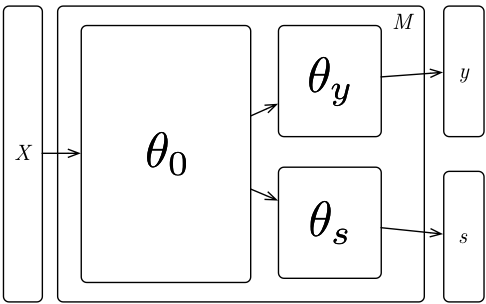Note: use
pandoc README.md -o README.pdfto generate a PDF rendering this file (or open it in Atom and preview the markdown using the plugin markdown-preview-plus).
Let us consider a matrix
Let us then consider the network architecture shown below:
Let
The idea is as it follows:
- consider a new batch
$X'$ of examples; - the batch is used to compute a new representation
$\chi$ for the examples as$\chi = N_{\theta_0}(X')$ ; - train $\mathcal{N}{\theta_y}$ and $\mathcal{N}{\theta_y}$ over
$\chi$ up to convergence using:$$\arg\min_{\theta_y} L_{\theta_y}(y, \mathcal{N_{\theta_y}(\chi)})$$ $$\arg\min_{\theta_s} L_{\theta_s}(s, \mathcal{N_{\theta_s}(\chi)})$$
- evaluate
$\sigma = \mathcal{N}_{\theta_s}(\chi)$ - evaluate
$\gamma = \mathcal{N}_{\theta_y}(\chi)$ - update
$\theta_0$ weights by back-propagating the error on the loss$$L(y,\gamma, s, \sigma) = L_{\theta_y}(y, \gamma) - \lambda L_{\theta_s}(s,\sigma)$$
- where
$\lambda$ is a parameter specifying how important is the fairness in the decision.
Upon convergence one evaluates the accuracy of the network in predicting
- if the accuracy on
$s$ is low enough, one can conclude that there is not enough information on the last layer of$\theta_0$ to predict$s$ ; - if the accuracy on
$y$ is still good enough, we obtained a good enough classifier whose prediction does not depend on$s$ nor any information about$s$ that can be reconstructed from$X$ .
Run the following commands:
git clone https://github.com/ml-unito/fair-networks
cd fair-networks
export PYTHONPATH="packages/:$PYTHONPATH"
export PATH="bin:$PATH" # put the preceeding two lines in your ~/.bashrc for ease of use
virtualenv venv --python=python3.6
source venv/bin/activate
pip3 install -r requirements.txt
pip install theano
mkdir experiments/firstThen create a file experiments/first/config.json containing the following:
{
"learning_rate": 0.01,
"schedule": "m30:c10",
"hidden_layers": "50",
"class_layers": "50",
"sensible_layers": "50",
"fairness_importance": 0.5,
"dataset": "default",
"batch_size": 128,
"noise_type": "sigmoid_sep",
"dataset_base_path": "../../data",
"model_dir": "models/",
"eval_data": null,
"eval_stats": false,
"random_seed": 42,
"output": null,
"resume_ckpt": null,
"checkpoint": "models/model.ckpt",
"save_model_schedule": "3000:100"
}Lastly, to perform the experiment and print results run:
fair_networks experiments/first/config.json
make
cat experiments/first/performances.tsvMany parameters in config.json are self explanatory, but a non-exhaustive list follows:
schedule: how many epochs the network will be trained for. The expected syntax is m[num_epochs]:c[ignored value]
hidden_layers: how many layers and how many neurons should be included in the hidden layers of the network. There is no need to set the input size here. The expected syntax is [number of neurons in first layer:in second layer:...]
dataset: a string describing the dataset you would like to work on
Dataset wrappers included with the code are provided in the package packages/fair/datasets/.
Writing your own wrapper code for a new dataset should be easy enough by looking at any one of the other wrappers.
You will also need to add some argument handling code in packages/fair/utils/options.py.
Preprocessing functionalities are provided in packages/fair/datasets/dataset_base.py and should work for your own .csv file.
Note that you can either provide a download path for the data or put it in the data/ folder.
